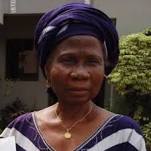Grace Oladunni Taylor facts for kids
Grace Oladunni Taylor, born on April 24, 1937, is a famous Nigerian scientist. She is a biochemist, which means she studies the chemistry of living things. Dr. Taylor used to work at the University of Ibadan in Nigeria. She made history as the second woman to join the Nigerian Academy of Science. She was also the first African woman to receive the special L'Oréal-UNESCO Award for Women in Science. This award celebrates women who do amazing things in science.
Contents
Early Life and Learning
Grace Oladunni Lucia Olaniyan was born in Efon-Alaiye, Ekiti State, Nigeria. Her parents were Elizabeth and R. A. W. Olaniyan.
School Days
From 1952 to 1956, Grace went to the Queen's School in Ede, located in Osun State. After that, in 1957, she started her college studies at the Nigerian College of Arts and Science in Enugu.
University Education
In 1959, she moved to the University College of Ibadan, which is now known as Ibadan University. Grace worked very hard and graduated with high honors in 1962. Her degree was in chemistry.
Career and Discoveries
After finishing her degree, Grace Oladunni Taylor started working right away. She joined the Regional Agricultural Research Station in Ibadan. This place is now called the National Root Crops Research Institute.
Starting Her Research Journey
In 1963, she became a research assistant at Ibadan University. She worked in the department that studied chemical pathology. This is where she earned her doctorate degree in chemical pathology in 1969. A doctorate is the highest degree you can get in a field of study.
Becoming a Professor
In 1970, the university hired her as a lecturer. A lecturer is like a teacher at a university. She visited the Northwest Lipid Research Laboratory in Seattle, Washington in 1975 to do more research. When she returned to Ibadan University, she was promoted to senior lecturer. By 1979, she became a "reader," which is another high academic rank. Around this time, she married Professor Ajibola Taylor.
Dr. Taylor continued to travel and learn. In 1980, she was a visiting scientist at the University of West Indies in Kingston, Jamaica. Then, in 1984, she became a full professor of chemical pathology at Ibadan University. This was a big achievement! That same year, she went back to Seattle for more research. She also worked as a visiting scientist in Port of Spain, Trinidad.
Leading and Mentoring
In 1990, Dr. Taylor worked at the University of Zimbabwe School of Medicine in Harare. She taught in the pathology department there. In 1991, she returned to Ibadan University. From 1991 to 1994, she was the head of the chemical pathology department. She also worked as a special consultant at the University College Hospital in Ibadan. She retired in 2004 but kept teaching at Ibadan University.
Important Research
Dr. Taylor's main area of study was lipids. Lipids are like fats in our bodies. She studied how lipids are connected to heart diseases. Her research showed that cholesterol levels are not just about a person's race. Instead, they are more about what people eat and how much they exercise. This was a very important discovery!
Awards and Recognition
Grace Oladunni Taylor received many awards for her amazing research. These included:
- The Shell-BP Scholarship in Chemistry
- A World Health Organization Fellowship
- The Fulbright–Hays Fellowship
- A Ciba-Geigy Fellowship
- The Association of African Universities Fellowship
In 1997, she was welcomed into the Nigerian Academy of Science. She was only the second woman ever to receive this honor. In 1998, the L'Oréal-UNESCO prize was created. This award celebrates women scientists from different parts of the world. Dr. Taylor was the first African woman to receive this special L'Oréal-UNESCO Award for Women in Science. In 2012, the Ekiti State Government honored her. They recognized her for helping and teaching many medical students.
See also
 In Spanish: Grace Oladunni Taylor para niños
In Spanish: Grace Oladunni Taylor para niños


